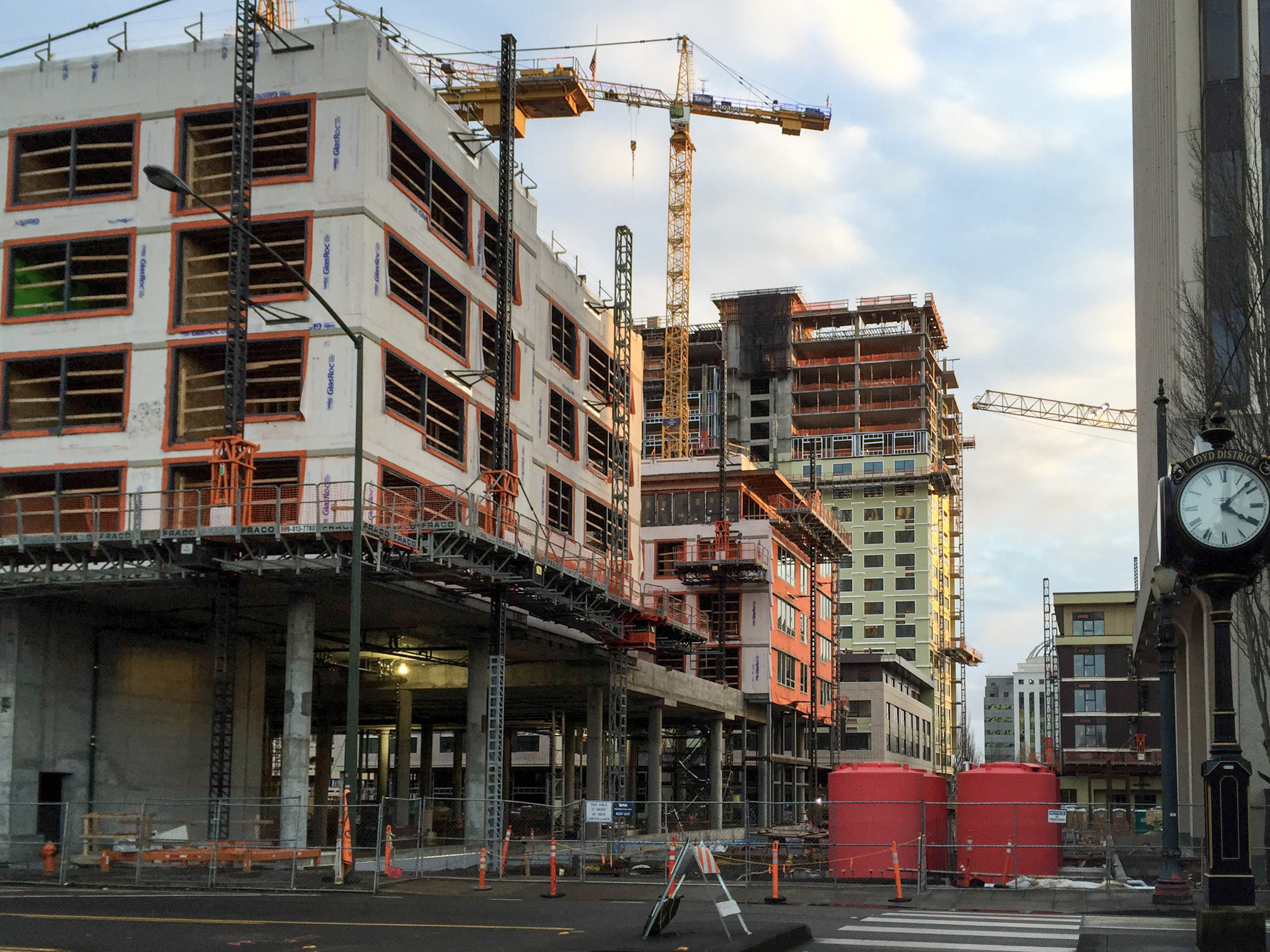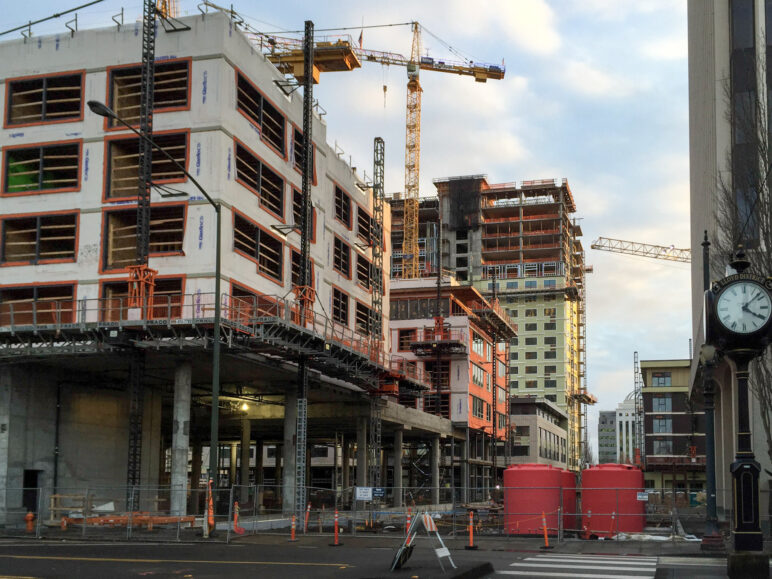Hey, here’s some cash. While you’re at the store, would you grab me some eggs?
That’s the simple, efficient premise behind the housing policy just approved by Oregon’s most populous city and county. Here’s some cash. While you’re building those apartments, set aside some of them to be rented at less than the market rate.
In a 3-2 vote Thursday, the Board of Multnomah County Commissioners followed up on a unanimous Jan. 31 vote by the Portland City Council to fully fund this concept in the form of Portland’s inclusionary housing program for rental projects.
Together, the two votes will remove what has been a major obstacle to new apartment buildings in close-in Portland neighborhoods. In most of the city, what had been an underfunded mandate will no longer be underfunded.
“It just makes our entire city more equitable,” Multnomah County Chair Jessica Vega Pederson, an East Portland resident who spearheaded the county action, said Wednesday. “People at many different income levels have opportunities to live close to where their jobs are.”
You get what you pay for
It’s easy to overthink “inclusionary zoning” programs like Portland’s, but the concept is not complicated: New buildings should include homes priced for a mix of different incomes.
The problem is how to get a good quantity of mixed-income apartment buildings to exist. If you required 30 percent of homes in every new building to be priced at less than the cost of building them, you wouldn’t get a mixed-income building; you’d get nothing at all. Thirty percent of zero would be zero.
With this round of changes that takes effect March 1, Portland has faced that problem head-on and come up with a relatively simple answer. Fully fund the gap between costs and prices.
Don’t just ask for the eggs; pay for the eggs.
“We only get those homes if private-sector projects move forward, and they only move forward if the financials make sense,” Portland Commissioner Carmen Rubio, who steered the reform through City Hall, said last month.
Portland’s program in brief: For new apartment buildings of 20 or more homes, at least 10 percent must be set aside for people earning no more than 60 percent of the metro area’s median income. (Currently, that 60 percent limit comes to $54,180 for a household of two, for example.) Those homes’ rents, meanwhile, must be capped at levels those households can afford. (No more than $1,250 a month or so for a one-bedroom, for example.) The price restriction lasts for 99 years.
The government then makes up for that reduced revenue, mostly with a temporary property tax break, to keep the project in the black.
There are a few other options for new buildings to comply, such as putting below-market homes in a comparable location elsewhere. But with this being the only option that’s fully funded in higher-rent parts of the city, it’s expected to be by far the most common choice.
If you do the math to calculate the public’s cost per home, the below-market housing created via fully funded inclusionary housing is less expensive than a comparable home created by a local housing bond. That’s presumably because the affordable homes hitch a ride on a project that was already being financed.
“We have to go where the data tells us”
The city’s inclusionary housing program had already been fully funded for years in Portland’s “central city,” the approximately one-mile radius around Pioneer Courthouse Square. But outside central Portland, the program’s funding had been tightly limited by the city and county, which must both sign off on any tax abatement.
The result of this underfunding over the last seven years had been that many projects bent over backward to avoid the program. The share of new homes in 12- to 19–unit buildings, those just below the program’s threshold, had approximately doubled. Hundreds and maybe thousands of other homes likely weren’t built at all, in part because of cost gaps left behind by the underfunded program.
“We have to go where the data tells us,” Multnomah County Commissioner Lori Stegmann said Thursday, voting to support the revised program. “Look, it’s working in this area, but it’s not working in this area. So how can we be pretty precise and make these little tweaks?”
Joining Stegmann and Vega Pederson in support of the program Thursday was Commissioner Jesse Beason. Voting against it were commissioners Sharon Meieran and Julia Brim-Edwards. They expressed concern about the program’s potential cost in forgone revenue, preferring a version that would have eliminated both the tax subsidy and the affordability mandate if the total tax abatement had exceeded $60 million over five years.
Economists for both the city and county called that a remote possibility. And Stegmann said it didn’t worry her in any case, since the larger property tax base would still wind up in government coffers after the 10-year property tax break expires.
“Worst-case scenario, you have hundreds of developers rushing to market to build affordable housing,” she said. “I’m fine with that.”
A slow but steady payoff
Despite various claims made over the years, Portland’s previously underfunded affordability mandate wasn’t the only thing stopping homebuilding in the city. And the full funding of the program, which begins March 1 but will be retroactively available to projects already in progress, won’t lead to an immediate rebound in apartment construction.
After all, the city’s population has been falling for a few years. The bright side of this is that vacancy rates are above 5 percent, leaving landlords with little power to raise prices. Rents in Portland proper have, for a change, been more or less flat since 2020.
Until local population growth picks up again, this way to fund the program—through temporary property tax breaks on new buildings—will cost the government almost nothing. And when population growth does at some point pick up again, fully funding the inclusionary housing program should help Portland avoid falling behind on homebuilding. This, in turn, should help avoid a rock-bottom vacancy rate followed by a rent-hike crisis. That’s what Portland went through from 2010 to 2017.
And, thanks to public funding, the program will also ensure that new buildings in opportunity-rich areas will be mixed-income on day one.
Portland’s program still has flaws. For one thing, these changes don’t fix the formula for condo buildings of 20 or more homes, which all but vanished from Portland after the program launched and will now struggle even more to compete against apartment projects. The program likely remains underfunded in a handful of mid-price neighborhoods like Woodstock and St. Johns; in other mid-price neighborhoods like Montavilla, it may actually be overfunded.
But the city and county have also agreed to check in on the program again in 2027. That’s another important feature of a functional inclusionary housing program. It needs regular calibration as economic conditions change.
Inclusionary zoning, even when fully funded, probably isn’t a good fit for every city. Even at its best, it’s just too complicated. But cities that want such programs should look to Portland and Multnomah County, especially if it turns out that Portland’s next wave of private homebuilding includes a surge in production of new below-market homes.










Wayne Lei
Smart idea. Well done!
Matt Warning
I’m not very knowledgeable about housing but I’m curious why there isn’t more emphasis on expansion of Section 8 housing vouchers. It’s a means-tested program that makes housing affordable for those in need and it provides good incentives for increasing the housing stock. Also, section 8 folks are really good tenants because they always have their rent because the vouchers aren’t fungible.
Again, this isn’t my field–I study rural poverty in Africa and Latin America–but Section 8 seems like a very uncomplicated way to achieve multiple objectives.
Thanks,
Matt
Michael Andersen
Great question, Matt. Sightline is generally a big supporter of Section 8 vouchers; a few years ago, I wrote this case for fully funding them by making them an automatic entitlement for anyone below a certain income, as opposed to doling them out using long waitlists – a sure way to help people years after they need it.
Some downsides of vouchers are:
– because they only subsidize rents up to a certain sum, they don’t offer full freedom of location
– because the biggest rent-payer is usually the government rather than the tenant, they give the tenant very little power in negotiations with their landlord; they sorta pay landlords to let their properties slowly disintegrate
– they may be unavailable to undocumented folks or to people who live with undocumented folks (some might call this an upside, though I wouldn’t personally)
Tax-abatement-funded inclusionary housing gets around those problems, at least a bit, in exchange for other problems.